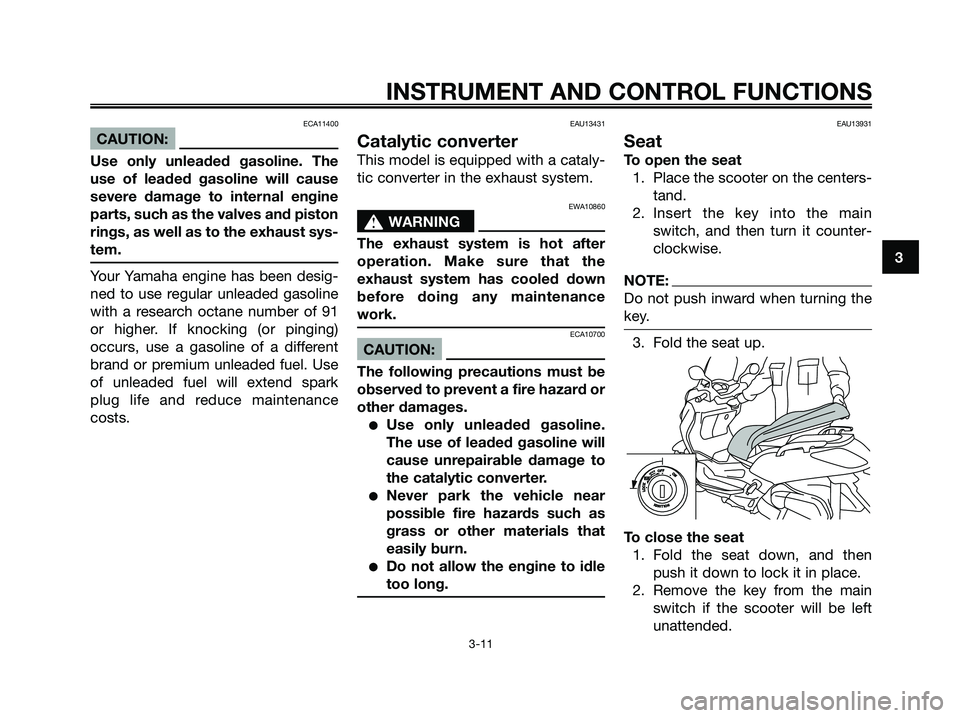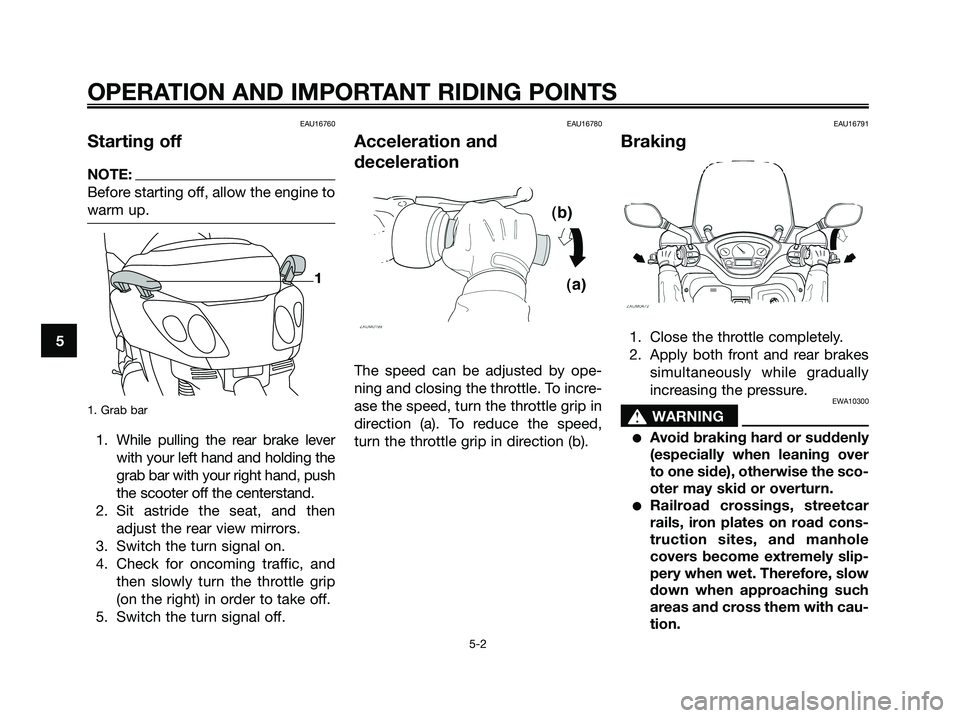Page 24 of 76

EAU13161
Fuel tank cap
To open the fuel tank cap
1. Open the lid by sliding the lever
forward, and then pull the lever
up.
2. Insert the key into the lock and
turn it clockwise. The lock will be
released and the fuel tank cap
can be removed.
To install the fuel tank cap
1. Align the match marks, insert the
fuel tank cap into the tank ope-
ning, and then push down on the
cap.
2. Turn the key counterclockwise to
the original position, and then
remove it.
3. Close the lid.
EWA11120
s s
WARNING
Be sure that the fuel tank cap is
properly installed and locked befo-
re riding the scooter.
EAU13230
Fuel
Make sure that there is sufficient fuel
in the tank.
1. Fuel tank
2. Fuel level
EWA10990
s s
WARNING
Since gasoline is flammable, the
following precautions must be
observed.
�Stop the engine before refue-
ling.
�Never attempt to refuel the
scooter while smoking or near
an open flame.
�Take special care not to spill
gasoline over the engine or
muffler when refueling imme-
diately after operation.
�Before starting the engine,
quickly wipe off any gasoline
spilled on the engine or muffler.
ECA10070
CAUTION:
Immediately wipe off spilled fuel
with a clean, dry, soft cloth, since
fuel may deteriorate painted surfa-
ces or plastic parts.
EAU33500
Recommended fuel:
REGULAR UNLEADED GASOLINE
ONLY
Fuel tank capacity:
12,5 L (2,75 US gal) (11 Imp.gal)
Fuel reserve amount (when the fuel
level warning symbol comes on):
2 L (0,44 US gal) (1,76 Imp.gal)
3
INSTRUMENT AND CONTROL FUNCTIONS
3-10
1B9-F8199-E0.qxd 14/10/2005 11:06 Página 3-10
Page 25 of 76

ECA11400
CAUTION:
Use only unleaded gasoline. The
use of leaded gasoline will cause
severe damage to internal engine
parts, such as the valves and piston
rings, as well as to the exhaust sys-
tem.
Your Yamaha engine has been desig-
ned to use regular unleaded gasoline
with a research octane number of 91
or higher. If knocking (or pinging)
occurs, use a gasoline of a different
brand or premium unleaded fuel. Use
of unleaded fuel will extend spark
plug life and reduce maintenance
costs.
EAU13431
Catalytic converter
This model is equipped with a cataly-
tic converter in the exhaust system.
EWA10860
s s
WARNING
The exhaust system is hot after
operation. Make sure that the
exhaust system has cooled down
before doing any maintenance
work.
ECA10700
CAUTION:
The following precautions must be
observed to prevent a fire hazard or
other damages.
�Use only unleaded gasoline.
The use of leaded gasoline will
cause unrepairable damage to
the catalytic converter.
�Never park the vehicle near
possible fire hazards such as
grass or other materials that
easily burn.
�Do not allow the engine to idle
too long.
EAU13931
Seat
To open the seat
1. Place the scooter on the centers-
tand.
2. Insert the key into the main
switch, and then turn it counter-
clockwise.
NOTE:
Do not push inward when turning the
key.
3. Fold the seat up.
To close the seat
1. Fold the seat down, and then
push it down to lock it in place.
2. Remove the key from the main
switch if the scooter will be left
unattended.
3
INSTRUMENT AND CONTROL FUNCTIONS
3-11
1B9-F8199-E0.qxd 14/10/2005 11:06 Página 3-11
Page 29 of 76
3
INSTRUMENT AND CONTROL FUNCTIONS
3-15
With the engine turned off:
1. Move the sidestand down.
2. Make sure that the engine stop switch is turned on.
3. Turn the key on.
4. Keep the front or rear brake applied.
5. Push the start switch.
Does the engine start?
With the engine still off:
6. Move the sidestand up.
7. Keep the front or rear brake applied.
8. Push the start switch.
Does the engine start?
With the engine still running:
9. Move the sidestand down.
Does the engine stall?
The system is OK. The scooter can be ridden.
This check is most reliable if performed with
a warmed-up engine.
The sidestand switch may be defective.
The scooter should not be ridden until
checked by a Yamaha dealer.
The brake switch may be defective.
The scooter should not be ridden until
checked by a Yamaha dealer.
The sidestand switch may be defective.
The scooter should not be ridden until
checked by a Yamaha dealer.
YES NO YES NO NO YESNOTE:
1B9-F8199-E0.qxd 14/10/2005 11:06 Página 3-15
Page 31 of 76

4
PRE-OPERATION CHECKS
4-2
EAU15603
Pre-operation check list
ITEM CHECKS PAGE
• Check fuel level in fuel tank.
Fuel• Refuel if necessary. 3-4, 3-10
• Check fuel line for leakage.
• Check oil level in engine.
Engine oil• If necessary, add recommended oil to specified level. 6-8
• Check vehicle for oil leakage.
Final transmission oil• Check vehicle for oil leakage. 6-10
• Check coolant level in reservoir.
Coolant• If necessary, add recommended coolant to specified level. 3-4, 6-11
• Check cooling system for leakage.
• Check operation.
• If soft or spongy, have Yamaha dealer bleed hydraulic system.
Front brake• Check brake pads for wear.
3-9, 5-2, 6-17
• Replace if necessary.
• Check fluid level in reservoir.
• If necessary, add recommended brake fluid to specified level.
• Check hydraulic system for leakage.
• Check operation.
• If soft or spongy, have Yamaha dealer bleed hydraulic system.
Rear brake• Check brake pads for wear.
3-9, 5-2, 6-17
• Replace if necessary.
• Check fluid level in reservoir.
• If necessary, add recommended brake fluid to specified level.
• Check hydraulic system for leakage.
• Make sure that operation is smooth.
Throttle grip• Check cable free play.
5-2, 6-14, 6-19
• If necessary, have Yamaha dealer adjust cable free play and lubricate
cable and grip housing.
• Check for damage.
Wheels and tires• Check tire condition and tread depth.
6-15 ~ 6-17
• Check air pressure.
• Correct if necessary.
1B9-F8199-E0.qxd 14/10/2005 11:06 Página 31
Page 33 of 76

EAU15970
EWA11250
s s
WARNING
�Become thoroughly familiar
with all operating controls and
their functions before riding.
Consult a Yamaha dealer
regarding any control or func-
tion that you do not thoroughly
understand.
�Never start the engine or ope-
rate it in a closed area for any
length of time. Exhaust fumes
are poisonous, and inhaling
them can cause loss of cons-
ciousness and death within a
short time. Always make sure
that there is adequate ventila-
tion.
�For safety, always start the
engine with the centerstand
down.
�When the centerstand is down
and the engine is idling, keep
your hands and feet away from
the rear wheel.
EAUM1210
Starting a cold engineECA10250
CAUTION:
See page 5-3 for engine break-in
instructions prior to operating the
vehicle for the first time.
1. Turn the key to “f”.
2. Close the throttle completely.
3. Start the engine by pushing the
start switch while applying the
front or rear brake.
NOTE:
If the engine fails to start, release the
start switch, wait a few seconds, and
then try again. Each starting attempt
should be as short as possible to pre-
serve the battery. Do not crank the
engine more than 10 seconds on any
one attempt.
ECA11040
CAUTION:
For maximum engine life, never
accelerate hard when the engine is
cold!
5
OPERATION AND IMPORTANT RIDING POINTS
5-1
1B9-F8199-E0.qxd 14/10/2005 11:06 Página 33
Page 34 of 76

EAU16760
Starting off
NOTE:
Before starting off, allow the engine to
warm up.
1. Grab bar
1. While pulling the rear brake lever
with your left hand and holding the
grab bar with your right hand, push
the scooter off the centerstand.
2. Sit astride the seat, and then
adjust the rear view mirrors.
3. Switch the turn signal on.
4. Check for oncoming traffic, and
then slowly turn the throttle grip
(on the right) in order to take off.
5. Switch the turn signal off.
EAU16780
Acceleration and
deceleration
The speed can be adjusted by ope-
ning and closing the throttle. To incre-
ase the speed, turn the throttle grip in
direction (a). To reduce the speed,
turn the throttle grip in direction (b).
EAU16791
Braking
1. Close the throttle completely.
2. Apply both front and rear brakes
simultaneously while gradually
increasing the pressure.
EWA10300
s s
WARNING
�Avoid braking hard or suddenly
(especially when leaning over
to one side), otherwise the sco-
oter may skid or overturn.
�Railroad crossings, streetcar
rails, iron plates on road cons-
truction sites, and manhole
covers become extremely slip-
pery when wet. Therefore, slow
down when approaching such
areas and cross them with cau-
tion.
1
5
OPERATION AND IMPORTANT RIDING POINTS
5-2
1B9-F8199-E0.qxd 14/10/2005 11:06 Página 34
Page 35 of 76

�Keep in mind that braking on a
wet road is much more difficult.
�Ride slowly down a hill, as bra-
king downhill can be very diffi-
cult.
EAU16820
Tips for reducing fuel
consumption
Fuel consumption depends largely on
your riding style. Consider the follo-
wing tips to reduce fuel consumption:
�Avoid high engine speeds during
acceleration.
�Avoid high engine speeds with no
load on the engine.
�Turn the engine off instead of let-
ting it idle for an extended length
of time (e.g., in traffic jams, at
traffic lights or at railroad cros-
sings).
EAU16841
Engine break-in
There is never a more important
period in the life of your engine than
the period between 0 and 1600 km
(1000 mi). For this reason, you should
read the following material carefully.
Since the engine is brand new, do not
put an excessive load on it for the first
1600 km (1000 mi). The various parts
in the engine wear and polish them-
selves to the correct operating clea-
rances. During this period, prolongedfull-throttle operation or any condition
that might result in engine overhea-
ting must be avoided.
EAUM2010
0~1000 km (0~600 mi)
Avoid prolonged operation above 1/3
throttle.
1000~1600 km (600~1000 mi)
Avoid prolonged operation above 1/2
throttle.
ECA11660
CAUTION:
After 1000 km (600 mi) of operation,
be sure to replace the engine oil
and final transmission oil.
1600 km (1000 mi) and beyond
The vehicle can now be operated nor-
mally.
ECA10270
CAUTION:
If any engine trouble should occur
during the engine break-in period,
immediately have a Yamaha dealer
check the vehicle.
5
OPERATION AND IMPORTANT RIDING POINTS
5-3
1B9-F8199-E0.qxd 14/10/2005 11:06 Página 35
Page 36 of 76
EAU17212
Parking
When parking, stop the engine, and
then remove the key from the main
switch.
EWA10310
s s
WARNING
�Since the engine and exhaust
system can become very hot,
park in a place where pedes-
trians or children are not likely
to touch them.
�Do not park on a slope or on
soft ground, otherwise the
vehicle may overturn.
ECA10380
CAUTION:
Never park in an area where there
are fire hazards such as grass or
other flammable materials.
5
OPERATION AND IMPORTANT RIDING POINTS
5-4
1B9-F8199-E0.qxd 14/10/2005 11:07 Página 36